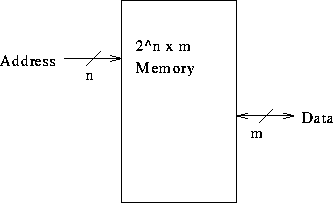Memory: ROM and RAM
Tom Kelliher, CS 220
Nov. 30, 2001
Course evaluations end of class Monday.
Read 6.2--4.
Counter project overview.
- Introduction.
- ROM.
- RAM.
Details on RAM.
- What is memory?
- Volatile vs. non-volatile.
- RAM characteristics: speed, density, power.
- Memory hierarchy: registers, cache, main memory, etc.
- General structure:

- Technologies: PROM, EPROM (UV), EEPROM, EAPROM.
- Where do you find ROM in a PC?
- Structure of a ROM:

Minterms, fusible links.
- Usage: program storage, generation of combinational functions.
How do you use for combinational functions?
- Additional inputs: !Enable, Read/!Write
- Static RAM: latches, inverter pair.
Used for caches. Fast. Not dense. High power.
- Dynamic RAM: stored charge on a capacitor.
- Leakage, refresh.
- Used for main memory. Slow. Dense. Low power.
- Sizes. I/O pin limitations. Solutions: one bit wide, address
multiplexing. 2-D structure.
- Additional inputs: RAS, CAS.
- Read/Write sequences.
Write strobe with respect to the clock signal. Importance of address bus
settling before write asserts.
Thomas P. Kelliher
Fri Nov 30 10:52:25 EST 2001
Tom Kelliher


